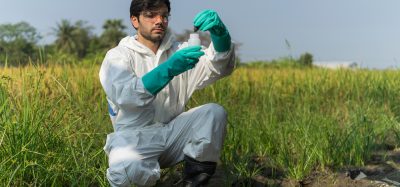Allergen management in the food industry: it’s all about cross-contact and contamination prevention
Posted: 13 June 2017 | Dr Bert Popping - FOCOS, François Bourdichon - Food Safety Consultant | No comments yet
Food allergies and other food sensitivities are individualistic adverse reactions to foods. The hazard may be defined as the inadvertent consumption of a food allergen by a sensitive individual. In this article François Bourdichon, Food Safety Consultant, and Bert Pöpping, FOCOS discuss true food allergies (reproducible adverse reactions to a particular food that involve the immune system).


All known food allergens are proteins; they can be present in the food in large quantities and often survive – even harsh – food-processing conditions.
The proportion of the population with a true food allergy is estimated at around 1-2% of adults and about 5-8% of children in western countries. Food allergens have become, in recent years, a major concern for food business operators, and are by far the main reason of product recalls for Ready to Eat Foods. The leading reason for food allergen control failure is not hazard detectability and control, but compliance with implementation of appropriate control measures.
On the other hand, a zero-allergen-tolerance policy tends to place an allergen label or warning on any product, even when the risk is negligible or possibly non-existent. While such measures may reduce risk, it is not beneficial for affected consumers, since it limits the number of potentially nutritious products available, thereby further reducing their quality of life. It may even put them in a position of having to perform the risk assessment, whether a food product is safe or not for them to consume.
The greatest challenge of allergen risk management is to achieve operational excellence within a rapidly and frequently changing manufacturing environment, to ensure alignment between the formula, product and package label. Successful management of food allergen issues places heavy reliance on pre-requisite programmes operating within the food business (e.g. sanitation, operators’ training and supplier management).
Allergen risk assessment: introduction of the hazard in the food chain
The first step in the risk assessment process is to consider the presence of the hazard, its introduction on the premises. If an ingredient or product contains an allergenic component as part of the recipe, these allergenic components have the potential to cross-contaminate other components and products produced on the very same premises. A hazard can also be introduced due to inappropriate hygienic practices (e.g. deviation to a peanut free policy in the cafeteria of food workers).
Food allergens occur in food through adventitious contamination, which can result from:
- Inadvertent presence in raw materials
- Processing aids (e.g. enzymes)
- Incorrect formulation
- Changes to product scheduling
- Rework
- Insufficient or ineffective cleaning/sanitation procedures
- In-process cross contact
- Post-process contact
The second step in the risk assessment process will identify the probability of unintentional presence of allergens, by thinking about how cross-contamination could happen and how likely it is to happen along the process.
Implementing an allergen control plan
The introduction of allergen management into a food business should be seen as an extension of the existing food safety management rather than a completely new system1-3. Controlling the introduction, proliferation and elimination of allergens within the productions premises is based (at the very least) on the implementation of following control measures (nonexhaustive list)
- Supplier monitoring
- Plant traffic flow and Raw material storage
- Colour-coding systems for utensils used with allergens
- Production scheduling and use of rework
- Equipment and premises design
- Cleaning Operations
- Employee education
- New Product Development (Safety by Design).
Of note, while cleaning practices are classically referred to as Good Manufacturing Practices (GMP) or Prerequisites in Place (PRPs), regarding the control of allergen, on a HACCP approach, they have to be considered as a CCP as they are the sole action in place to reduce and eliminate the hazard. They therefore require a proper validation, monitoring and verification schedule.
Supplier management
A product may become contaminated through its raw ingredients. Communication with ingredient suppliers is important to have them address the same allergen control practices as their clients.
A certificate of analysis or conformance is a first step to ensure that the raw materials meet the criteria set for their suitability for use in allergen-free products.
As an example, ingredients like lecithin can be obtained from an allergenic source like soy or egg, where the risk of allergenic reaction is, per se, negligible when extraction is properly carried out4.
Supplier management should require:
- Notification of any change in suppliers’ product formulations,
- Ensure that vehicles, tanker or pallets are free of gluten residues from previous shipments.
- A method to identify and trace product distribution.
Rationalised production scheme: zoning and rework
Whenever a food business operator expects to use allergenic ingredients within its premise, one must consider separation to control the spread of the allergen:
- By use of dedicated facilities and/or specific process lines
- Most classically, by use of designated areas (zones) for specific allergens
- By using physical barriers between the production lines
- By minimising unnecessary movement of materials and personnel
- By scheduling production runs (production planning), i.e. where possible, production runs should be scheduled in a way that products without allergenic materials are produced first (after the last full cleaning)
- By separating the air supply, where this is appropriate and practicable.
Procedures for the handling of rework in production must be in place. The principle should be ‘identical into identical’ i.e. rework should go into another batch or run of the same type of product. Where this is not practicable, allergen-containing rework should only be used in products where that specific allergen is already present; for example, reworking chocolate that contains hazelnuts or hazelnut fillings into other hazelnut-containing chocolate products. Oils used for cooking allergenic foods – for example, shellfish, fish and breaded or battered products – should not be used subsequently for cooking products not containing that allergen without undergoing a validated filtration step e.g. if filtration proves to reduce the hazard.
Sanitation
Ensuring good hygiene is even more important in the making of allergen-free products than ordinary products. Companies must have master sanitation schedule in place, designed to mitigate this hazard. The cleaning practices in place must consider their purpose, which hazard they seek to eliminate (from bacteria to particles).
In case separate premises are not feasible, sufficient cleaning between different stages of work must be ensured. Clean-up following the processing of an allergen-containing product is essential. Equipment may need to be disassembled and manually cleaned to ensure hard-to-clean areas are free of allergen residue.
All equipment shall be cleaned especially between formulation changes.
Once appropriate procedures for cleaning are established, a checklist may be utilised to verify systems are clean and inspected.
Use of immunoassays may detect gluten proteins; swabbing equipment may pinpoint the source.
Testing and analysis of allergens
Manufacturers of allergen-free products will need to ensure that their claims are not only backed by documentation from suppliers of ingredients but also confirmed by their own analysis. Additional analyses should also be performed in certain circumstances, e.g. when a consumer complaint has been received, an ingredient or process has changed in the formulation of a product or a new product is being manufactured.
Testing for food allergens is a valuable tool when used as part of a risk-based approach to allergen management. Test results can provide assurance and verification of critical controls within a comprehensive risk management programme.
The most routinely used analytical method for detecting the presence of food allergens is the Enzyme-Linked Immuno Sorbent Assay (ELISA) technique. The sensitivity of ELISA kits currently available is in the low parts per millions (ppm) reporting range.
While there are many benefits to using the ELISA method, there are some limitations to using and interpreting results, which must be considered. These may include protein extraction for analysis, effect of food processing on the protein conformation, cross-reactions with other epitopes.
Reference methods using more complicated techniques (LC-MS) are presently considered by AOAC to benchmark the existing alternative solutions.
Analytical testing is inappropriate for quality control purposes but supports upstream quality assurance, validating cross-contamination control capability. The typical applications of analytical testing are:
- Provision of quantitative data for the purposes of risk assessment
- Confirmation of raw materials composition and received CoA eventually
- Validation of allergen control measures such as cleaning practices, scheduling and segregation barriers.
Training
Employee awareness and training are the best defences against the cross-contamination of allergen-free products. Products may become contaminated through hands, clothes, air and working surfaces containing flour dust. Flour dust is carried around in hands and clothes. Prevention of cross-contamination is a necessary part of the manufacturing operation. Employee training should be ongoing and include:
- A clear definition of an allergen and the consequences for allergic individuals i.e. gluten and coeliac patients
- Procedures on the control and prevention of allergen contamination (employee practices, hand contact / washing, clothing)
- Proper documentation of production line cleaning
- How to recognise and report potential cross-contamination with allergens.
Most effective Allergen Management of a food product is somehow linked to the management of its integrity and authenticity, making sure the production is done the way one expects it to be, with the defined ingredients. The better one knows its product and how it is managed, the higher the chance to deliver to the consumer what is stated (labelled) on the package, including the implied promise of a safe experience. While it requires a specific risk assessment for hazard identification and ensuring existing control measures in place will be appropriate, an allergen control plan is classically well integrated within the food safety program of an operator. And, as for the other hazard, testing (if deemed appropriate) will not make the food safer, but prove effectiveness of implemented procedures.
Biographies




References
- Allergen Bureau, Food Industry guide to Allergen Management and Labelling, updated 2007. Available at: http://allergenbureau.net/wp-content/uploads/2013/11/Allergen_Guide_2007.pdf
- Food and Drinks Europe, Guidance on Food Allergen Management for Food Manufacturers, January 2013. Available at: http://www.fooddrinkeurope.eu/uploads/press-releases_documents/temp_file_FINAL_Allergen_A4_web1.pdf
- Food Standards Agency, Guidance on Allergen Management and Consumer Information, July 2006. Available at: https://www.food.gov.uk/sites/default/files/multimedia/pdfs/maycontainguide.pdf
- Institute of Food Technologists’ Expert Panel on Food Safety and Nutrition, Food Allergies and Other Food Sensitivities, Food Technology, September 2001, vol. 55, no. 9.









